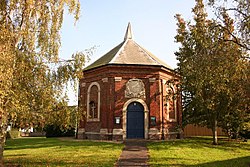Moulton Chapel
| Moulton Chapel | |
| Lincolnshire | |
|---|---|
 St James', Moulton Chapel | |
| Location | |
| Grid reference: | TF294182 |
| Location: | 52°44’47"N, 0°5’3"W |
| Data | |
| Population: | 3,504 (2011) |
| Post town: | Spalding |
| Postcode: | PE12 |
| Dialling code: | 01406 |
| Local Government | |
| Council: | South Holland |
| Parliamentary constituency: |
South Holland and The Deepings |
Moulton Chapel is a village in Holland, the south-eastern part of Lincolnshire. It is on the B1357 road, four miles south of Moulton, five miles south-west of Holbeach and four miles south-east of Spalding. It is one of a group of villages and hamlets known as The Moultons, the total population of which was 3,504 at the 2011 census.
History
In 1885 Kelly's Directory noted Moulton Chapel as a chapelry of Moulton, with a small octagonal chapel, erected in 1722. The living was a perpetual curacy.[1]
In 1722 the chapel of St James was rebuilt from an earlier chapel, by William Sands senior of Spalding. It was enlarged in 1886. In 1896 Moulton Chapel became a separate ecclesiastical parish under the name of Moulton St James.[2] Pevsner notes the church as a red-brick octagon with a chancel added in 1886, and a domed interior. The style is Dutch, influenced by late 17th-century fen drainers. There is a marble font, and a west gallery probably from the 19th century.[3] St James' is a Grade II* listed building.[4]
With St James', on Roman Road, is a Grade II listed 1865 red-brick tower windmill.[5]
In the late 1820s Thomas Nutt of Moulton Chapel developed and patented an improvement to beehives that allowed for heat regulation through improved ventilation, helped to prevent swarming, and encouraged bees to occupy other adjacent hives, thereby obviating the need to destroy bees in the collection of honey. The better welfare of bees produced a greater honey yield.[6][7][8][9] Nutt laid out his invention in his 1832 book Humanity to Honey Bees[10]
Outside links
| ("Wikimedia Commons" has material about Moulton Chapel) |
- Information on Moulton Chapel from GENUKI
- "Moulton Chapel Primary School"; Retrieved 3 June 2012
- Moulton Chapel on Vision of Britain
- "Fast End to a Ring Career"; Milwaukee Journal Sentinel, 21 May 1966. Retrieved 3 June 2012
References
- ↑ Kelly's Directory of Lincolnshire with the port of Hull 1885, p. 584
- ↑ Cox, J. Charles (1916) Lincolnshire p. 233; Methuen & Co. Ltd.
- ↑ Nikolaus Pevsner: The Buildings of England: Lincolnshire, 1964; 1989 Penguin Books ISBN 978-0-300-09620-0page 608
- ↑ National Heritage List 1359293: Chapel of St James, Roman Road (Grade II* listing)
- ↑ National Heritage List 1064467: Windmill, Roman Road (Grade II listing)
- ↑ Hebert, Luke (1836); The Engineer's and Mechanic's Encyclopaedia, Volume 1, Thomas Kelly, Paternoster Row, London, p. 162; reprinted February 2010. ISBN 1145467415
- ↑ Timms, John (1830); Arcana of Science and Art, Or, An Annual Register of Useful Inventions and Improvements, Discoveries; John Limbird p. 21; reprinted BiblioBazaar (2009). ISBN 1110719124
- ↑ The London Literary Gazette and Journal of Belles Lettres, Arts, Sciences, Etc (1833), p. 21; reprinted 2010. ISBN 114979920X
- ↑ Hebert, Luke (1829); The Register of arts, and journal of patent inventions, Volume 3, B. Steill, Paternoster Row, London, p. 228; reprinted BiblioBazaar (2010). ISBN 1143777514
- ↑ Nutt, Thomas (1832); Humanity To Honey Bees: Or Practical Directions For The Management Of Honey Bees Upon An Improved And Humane Plan; J. Leach, Wisbeach; reprinted Kessinger Publishing Co (2009). ISBN 1104181096
| Moulton and Moulton Fen, in Lincolnshire |
|---|
|
Moulton • Moulton Chapel • Moulton Eaugate • Moulton Fen • Moulton Seas End |
